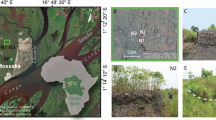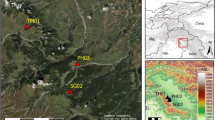Abstract
Archaeological excavation of barrows in the St Neot Valley on the southern flanks of Bodmin Moor revealed buried soils developed in the gravelly granitic head typical of the upland block. By comparing these soil profiles with adjacent soils we have obtained evidence for and now describe dramatic prehistoric changes in upland soils and vegetation attributed previously to various combinations of human influences and climatic events. Direct pedological and palaeoecological evidence supports the theory that brown soils existed in pre-Bronze Age times in southwestern England at a site subsequently developing an iron pan (Bf) and accumulating a strongly acid peaty surface.
This is a preview of subscription content, access via your institution
Access options
Subscribe to this journal
Receive 51 print issues and online access
$199.00 per year
only $3.90 per issue
Buy this article
- Purchase on Springer Link
- Instant access to full article PDF
Prices may be subject to local taxes which are calculated during checkout
Similar content being viewed by others
References
Griffith, F. Corn. Archaeol. 18, 56 (1979).
Clayden, B. Soils of the Exeter District (Soil Survey England and Wales, Harpenden, 1971).
Staines, S. J. Soil in Cornwall I (Soil Survey Record No. 34, Harpenden, 1976).
Avery, B. W. Soil Classification for England and Wales (Higher Categories) (Soil Survey Technical Monograph 14, Harpenden, 1980).
Bascomb, C. L. J. Soil Sci. 19, 251–268 (1968).
Bloomfield, C. Rep. Welsh Soils Discuss. Group 11, 112–123 (1970).
Davies, R. I. Rep. Welsh Soils Discuss. Group 11, 133–142 (1970).
Edwards, C. A. & Lofty, J. R. Biology of Earthworms (Chapman & Hall, London, 1972).
Jewell, P. A. & Dimbleby, G. W. Proc. prehist. Soc. 32, 313–342 (1966).
Staines, S. J. thesis, Univ. Bristol (1973).
Simons, I. G. Proc. prehist. Soc. 35, 203–219 (1969).
Staines, S. J. Proceedings Devon archaeol. Soc. 37, 21–47 (1979).
Staines, S. J. Cornish Archaeol. 14, 66–67 (1975).
Brisbane, M. & Clews, S. Cornish Archaeol. 18, 33–56 (1979).
Dimbleby, G. W. The Development of British Heathlands and Their Soils (Oxford Forestry Mem. No. 23, 1962).
Author information
Authors and Affiliations
Rights and permissions
About this article
Cite this article
Maltby, E., Caseldine, C. Prehistoric soil and vegetation development on Bodmin Moor, southwestern England. Nature 297, 397–400 (1982). https://doi.org/10.1038/297397a0
Received:
Accepted:
Issue Date:
DOI: https://doi.org/10.1038/297397a0
Comments
By submitting a comment you agree to abide by our Terms and Community Guidelines. If you find something abusive or that does not comply with our terms or guidelines please flag it as inappropriate.



